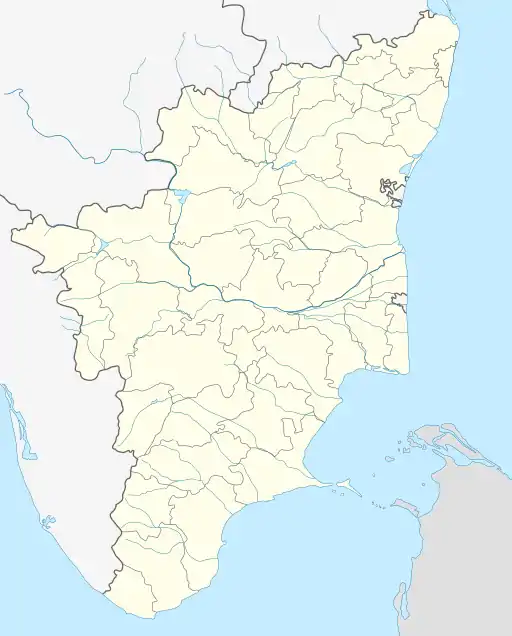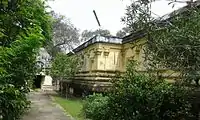Thiruchsemponsey
Thiruchsemponsey or Perarulaalan Perumal Temple is dedicated to Hindu god Vishnu located in Thirunangur, a village in the outskirts of Sirkazhi in the South Indian state of Tamil Nadu. Constructed in the Dravidian style of architecture, the temple is glorified in the Divya Prabandha, the early medieval Tamil canon of the Azhwar saints from the 6th–9th centuries AD. It is one of the 108 Divyadesam dedicated to Vishnu, who is worshipped as Peralulalan and his consort Lakshmi as Allimalar Nachiyar.
| Thiru semponsei koil | |
|---|---|
हेमरङ्गम् | |
 | |
| Religion | |
| Affiliation | Hinduism |
| District | Mayiladuthurai |
| Deity | Perarulaalan Perumal (Vishnu) Alli Mamalar (Lakshmi) |
| Festivals | iypasi swati bromotsavam |
| Features |
|
| Location | |
| Location | Thirunangur |
| State | Tamil Nadu |
| Country | India |
 Location in Tamil Nadu | |
| Geographic coordinates | 11°10′42″N 79°46′46″E |
| Architecture | |
| Type | Dravidian architecture |
| Direction of façade | east facing standing posture |
It is one among the eleven divyadesams of Thirunangur Tirupathis and is closely associated with Thirumangai Alvar. The temple is open from 8 a.m. to 10 a.m. and 5 p.m. to 7 p.m and has four daily rituals at various times of the day. The Thirumangai Azhwar Mangalasasana Utsavam celebrated annually during the Tamil month of Thai is the major festival of the temple during which the festival images of the eleven Thirunangur Tirupathis are brought on mount designed like Garuda, called Garuda Vahana, to Thirunangur.
Legend
The legend of all the eleven temples of Thirunangur are closely associated with each other. As per legend, the Hindu god Shiva in the form of Rudra started dancing in fury at this place after the death of his consort Uma due to the yagna (sacrifice) of Daksha. Each time his lock of hair touched the ground, there were eleven other forms of Shiva who appeared. The celestial deities were worried that if the dance continues, it would result in decimation of entire creations. They prayed to Vishnu for help, who appeared at this place. On seeing Vishnu, Shiva's anger was reduced and he requested Vishnu to appear in eleven forms like he did. On his request, Vishnu appeared in eleven different forms at Tirunangur. The eleven places where Vishnu appeared are believed to be where the eleven temples in Tirunangur are located.[1] It is believed that Vishnu advocated Rudra the importance of Dvadasanamems or the twelve Vaishnava marks in the respective parts of the body.[2]
Rama, the seventh avatar of Vishnu came to this place after killing Ravana. He made a golden idol of a cow and gifted to a Brahmin from the ashram of sage Dranethra, from where the place obtained its name. It is believed that Azhagiya Manavalar, the presiding deity at the Azhagiya Manavala Perumal Temple in Trichy came to this place at the request of Shiva.[3] The Brahmin is believed to have built the temple with the gold he obtained and hence it is called Thiruchemponsey (chempon indicated gold in Tamil).[4]
The Temple

The temple has a small temple complex. It is located in Thirunangur, a small village, 10 km away from Sirkali en route to Thiruvenkadu. The presiding deity is called Perarulalan and is depicted in standing posture facing east. The festival deity, Hemaranngar or Chemponarrangar, is a panchaloha idol housed in the sanctum. The consort of Hemarangar, Allimamlar Thayar is also housed in the sanctum.[4]
Religious significance
The temple is revered in Nalayira Divya Prabhandam, the 7th–9th century Vaishnava canon, by Periazhwar, Thirumalisai Alvar and Thirumangai Azhwar. The temple is classified as a Divyadesam, one of the 108 Vishnu temples that are mentioned in the book. During the 18th and 19th centuries, the temple finds mention in several works like 108 Tirupathi Anthathi by Divya Kavi Pillai Perumal Aiyangar.[5]
Worship practices and festivals
The temple is open from 8 a.m. to 10 a.m. and 5 p.m. to 7 p.m. The temple priests perform the pooja (rituals) during festivals and on a daily basis. As at other Vishnu temples of Tamil Nadu, the priests belong to the Pancharathra aagama Vaishnavaite community, a Brahmin sub-caste. The temple rituals are performed four times a day: Ushathkalam at 8 a.m., Kalasanthi at 10:00 a.m., Sayarakshai at 5:00 p.m. and Ardha Jamam at 7:00 p.m. Each ritual has three steps: alangaram (decoration), neivethanam (food offering) and deepa aradanai (waving of lamps) for both Perarulaalan and his consort Allimaamalaral Nachiyar. During the worship, religious instructions in the Vedas (sacred text) are recited by priests, and worshippers prostrate themselves in front of the temple mast. There are weekly, monthly and fortnightly rituals performed in the temple.The hereditary honors are received by the descendants of Sri Gomadam Azhagiyasingar family.[5]
During the new moon day of the Tamil month Thai, the festival deity of Thirumangai Azhwar is brought to the temple from Thiruvali-Thirunagari.[6] The Thirumangai Azhwar Mangalasasana Utsavam is celebrated in the Tamil month of Thai (January–February). The highlight of the festival is Garudasevai, an event in which the festival images of the eleven Thirunangur Tirupathis are brought on mount designed like Garuda, called Garuda Vahana, to Thirunangur. The festive image of Thirumangai Azhwar is also brought on a Hamsa Vahanam (palanquin) and his paasurams (verses) dedicated to each of these eleven temples are recited during the occasion. The festival images of Thirumangai Alvar and his consort Kumudavalli Naachiyar are taken in a palanquin to each of the eleven temples. The verses dedicated to each of the eleven temples are chanted in the respective shrines. This is one of the most important festivals in the region which draws thousands of visitors.[6][7]
Notes
- R. 2001, pp. 470-1
- Ayyar, P. V. Jagadisa (1982). South Indian Shrines: Illustrated. New Delhi: Asian Educational Services. p. 535. ISBN 9788120601512.
- R. 2001, pp. 498-9
- Anantharaman, Ambujam (2006). Temples of South India. East West Books (Madras). pp. 65–67. ISBN 978-81-88661-42-8.
- "Sri Perarulalan temple". Dinamalar. 2014. Retrieved 31 May 2014.
- S., Prabhu (12 July 2012). "Shrine dedicated to Arjuna". The Hindu. Retrieved 9 September 2013.
- "Garuda Sevai" (PDF). Ramanuja.org. Retrieved 19 August 2011.
References
- R., Dr. Vijayalakshmy (2001). An introduction to religion and Philosophy - Tévarám and Tivviyappirapantam (1st ed.). Chennai: International Institute of Tamil Studies.